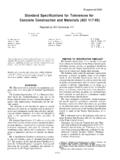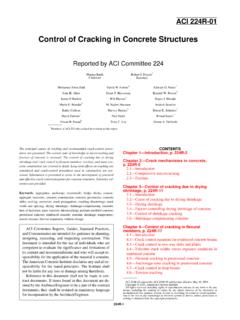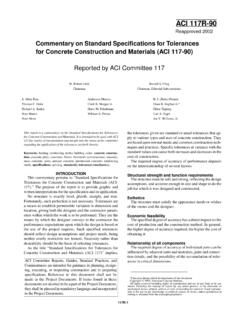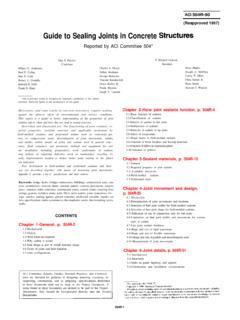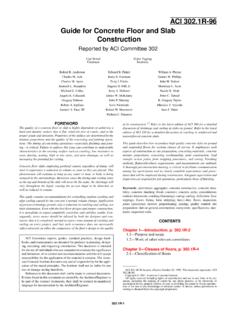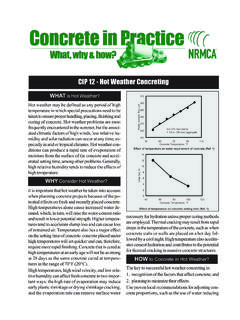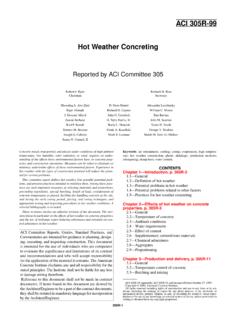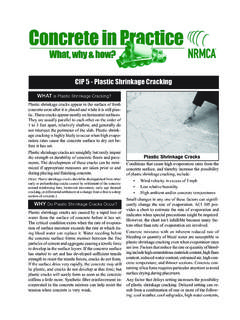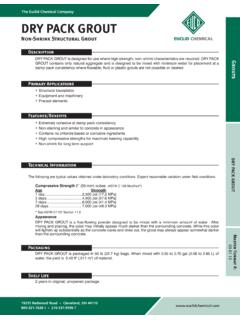Transcription of 308R-01 Guide to Curing Concrete - bpesol.com
1 ACI 308R-01 . Guide to Curing Concrete Reported by ACI Committee 308. Steven H. Gebler Cecil L. Jones Chairman Secretary Don Brogna Gene D. Hill, Jr. Aimee Pergalsky Edward P. Holub William S. Phelan Joseph Cabrera James N. Cornell II R. Doug Hooton Robert E. Price . Ronald L. Dilly * Larry R. Roberts Kenneth C. Hover Jonathan E. Dongell John C. Hukey Phillip Smith Ben E. Edwards Frank A. Kozeliski Luke M. Snell Derek Firth James A. Lee Joel Tucker Jerome H. Ford Daryl Manuel Patrick M. Watson Sid Freedman Bryant Mather John B. Wojakowski Gilbert J. Haddad Calvin McCall Samuel B. Helms H. Celik Ozyildirim * Chair of document subcommittee Deceased The term Curing is frequently used to describe the process by which are discussed in this document.
2 Curing measures, in general, are specified hydraulic-cement Concrete matures and develops hardened properties over in ACI Curing measures directed toward the maintenance of satis- time as a result of the continued hydration of the cement in the presence of factory Concrete temperature under specific environmental conditions are sufficient water and heat. While all Concrete cures to varying levels of addressed in greater detail by Committees 305 and 306 on Hot and Cold maturity with time, the rate at which this development takes place depends Weather Concreting, respectively, and by ACI Committees 301 and 318.
3 On the natural environment surrounding the Concrete , and the measures taken to modify this environment by limiting the loss of water, heat, or both, Keywords: cold weather; Concrete ; Curing ; Curing compound; hot weather con- from the Concrete , or by externally providing moisture and heat. The word struction; mass Concrete ; reinforced Concrete ; sealer; shotcrete; slab-on-ground. Curing is also used to describe the action taken to maintain moisture and temperature conditions in a freshly placed cementitious mixture to allow CONTENTS. hydraulic-cement hydration and, if applicable, pozzolanic reactions to Chapter 1 Introduction, p.
4 308R-2. occur so that the potential properties of the mixture may develop. Current Introduction Curing techniques are presented; commonly accepted methods, procedures, and materials are described. Methods are given for Curing pavements and Definition of Curing other slabs on ground, for structures and buildings, and for mass Concrete . Curing and the hydration of portland cement Curing methods for several specific categories of cement-based products Hydration of portland cement The need for Curing ACI Committee Reports, Guides, Standard Practices, Moisture control and temperature control and Commentaries are intended for guidance in planning, When deliberate Curing procedures are required designing, executing, and inspecting construction.
5 This Natural conditions document is intended for the use of individuals who are Sequence and timing of Curing steps for unformed competent to evaluate the significance and limitations of surfaces its content and recommendations and who will accept re- When Curing is required for formed surfaces sponsibility for the application of the material it contains. When Curing is required: cold and hot weather The American Concrete Institute disclaims any and all re- Duration of Curing sponsibility for the stated principles. The Institute shall The Curing -affected zone not be liable for any loss or damage arising therefrom.
6 Concrete properties influenced by Curing Reference to this document shall not be made in con- tract documents. If items found in this document are de- ACI 308R-01 became effective August 14, 2001. sired by the Architect/Engineer to be a part of the contract Copyright 2001, American Concrete Institute. All rights reserved including rights of reproduction and use in any form or by any documents, they shall be restated in mandatory language means, including the making of copies by any photo process, or by electronic or mechanical device, printed, written, or oral, or recording for sound or visual reproduc- for incorporation by the Architect/Engineer.
7 Tion or for use in any knowledge or retrieval system or device, unless permission in writing is obtained from the copyright proprietors. 308R-1. 308R-2 ACI COMMITTEE REPORT. Chapter 2 Curing methods and materials, p. 308R-12 CHAPTER 1 INTRODUCTION. Scope Introduction Use of water for Curing Concrete This Guide reviews and describes the state of the art for Initial Curing methods Curing Concrete and provides guidance for specifying Curing Fogging procedures. Curing practices, procedures, materials, and Liquid-applied evaporation reducers monitoring methods are described. Although the principles Final Curing measures and practices of Curing discussed in this Guide are applica- Final Curing measures based on the application ble to all types of Concrete construction, this document does of water not specifically address high-temperature or high-pressure Final Curing methods based on moisture retention accelerated Curing .
8 Termination of Curing measures Cold-weather protection and Curing Definition of Curing Protection against rapid drying in cold weather The term Curing is frequently used to describe the process Protection against frost damage by which hydraulic-cement Concrete matures and develops Rate of Concrete strength development in cold hardened properties over time as a result of the continued hy- weather dration of the cement in the presence of sufficient water and Removal of cold-weather protection heat. While all Concrete cures to varying levels of maturity Hot-weather protection and Curing with time, the rate at which this development takes place de- Accelerated Curing pends on the natural environment surrounding the Concrete Minimum Curing requirements and on the measures taken to modify this environment by General limiting the loss of water, heat, or both, from the Concrete , or Factors influencing required duration of Curing by externally providing moisture and heat.
9 The term cur- ing is also used to describe the action taken to maintain Chapter 3 Curing for different types of moisture and temperature conditions in a freshly placed ce- construction, p. 308R-19 mentitious mixture to allow hydraulic-cement hydration and, Pavements and other slabs on ground if applicable, pozzolanic reactions to occur so that the poten- General tial properties of the mixture may develop (ACI 116R and Curing procedures ASTM C 125). (A mixture is properly proportioned and ad- Duration of Curing equately cured when the potential properties of the mixture Buildings, bridges, and other structures are achieved and equal or exceed the desired properties of General the Concrete .)
10 The Curing period is defined as the time period Curing procedures beginning at placing, through consolidation and finishing, Duration of Curing and extending until the desired Concrete properties have de- Mass Concrete veloped. The objectives of Curing are to prevent the loss of General moisture from Concrete and, when needed, supply additional Methods and duration of Curing moisture and maintain a favorable Concrete temperature for Form removal and Curing formed surfaces a sufficient period of time. Proper Curing allows the cemen- Curing colored Concrete floors and slabs titious material within the Concrete to properly hydrate.
